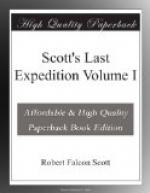It looks as though we were descending slightly; sastrugi remain as in forenoon. It is wearisome work this tugging and straining to advance a light sledge. Still, we get along. I did manage to get my thoughts off the work for a time to-day, which is very restful. We should be in a poor way without our ski, though Bowers manages to struggle through the soft snow without tiring his short legs.
Only 51 miles from the Pole to-night. If we don’t get to it we shall be d——d close. There is a little southerly breeze to-night; I devoutly hope it may increase in force. The alternation of soft snow and sastrugi seem to suggest that the coastal mountains are not so very far away.
Sunday, January 14.—Camp 66. Lunch T. -18 deg., Night T. -15 deg.. Sun showing mistily through overcast sky all day. Bright southerly wind with very low drift. In consequence the surface was a little better, and we came along very steadily 6.3 miles in the morning and 5.5 in the afternoon, but the steering was awfully difficult and trying; very often I could see nothing, and Bowers on my shoulders directed me. Under such circumstances it is an immense help to be pulling on ski. To-night it is looking very thick. The sun can barely be distinguished, the temperature has risen, and there are serious indications of a blizzard. I trust they will not come to anything; there are practically no signs of heavy wind here, so that even if it blows a little we may be able to march. Meanwhile we are less than 40 miles from the Pole.
Again we noticed the cold; at lunch to-day (Obs.: Lat. 89 deg. 20’ 53’’ S.) all our feet were cold, but this was mainly due to the bald state of our finnesko. I put some grease under the bare skin and found it made all the difference. Oates seems to be feeling the cold and fatigue more than the rest of us, but we are all very fit. It is a critical time, but we ought to pull through. The barometer has fallen very considerably and we cannot tell whether due to ascent of plateau or change of weather. Oh! for a few fine days! So close it seems and only the weather to baulk us.
Monday, January 15.—Lunch camp, Height 9,950. Last depot. During the night the air cleared entirely and the sun shone in a perfectly clear sky. The light wind had dropped and the temperature fallen to -25 deg., minimum -27 deg.. I guessed this meant a hard pull, and guessed right. The surface was terrible, but for 4 3/4 hours yielded 6 miles (geo.). We were all pretty well done at camping, and here we leave our last depot—only four days’ food and a sundry or two. The load is now very light, but I fear that the friction will not be greatly reduced.
Night, January 15.—Height 9920. T. -25 deg.. The sledge came surprisingly lightly after lunch—something from loss of weight, something, I think, from stowage, and, most of all perhaps, as a result of tea. Anyhow we made a capital afternoon march of 6.3 miles, bringing the total for the day to over 12 (12.3). The sastrugi again very confused, but mostly S.E. quadrant; the heaviest now almost east, so that the sledge continually bumps over ridges. The wind is from the W.N.W. chiefly, but the weather remains fine and there are no sastrugi from that direction.




